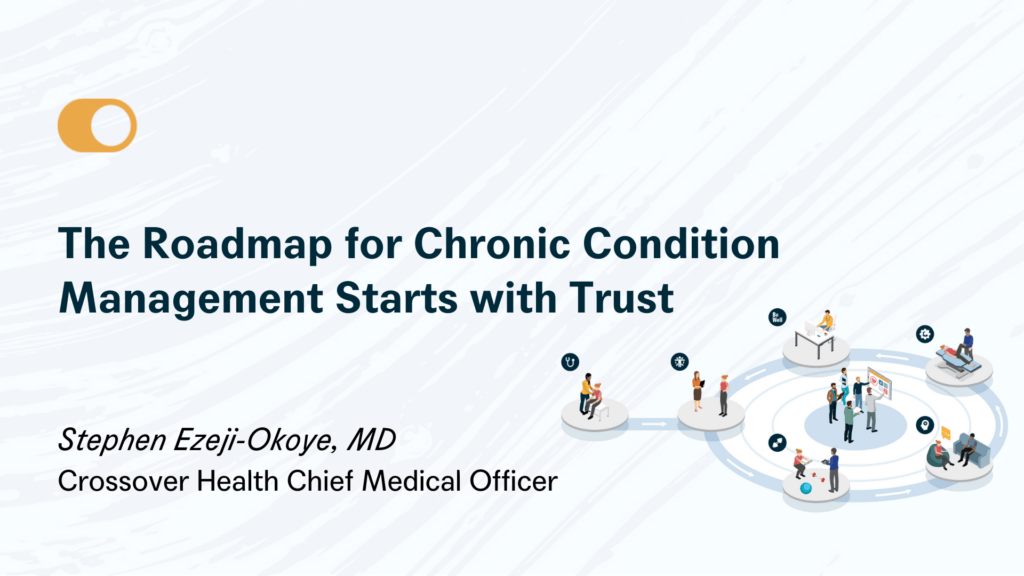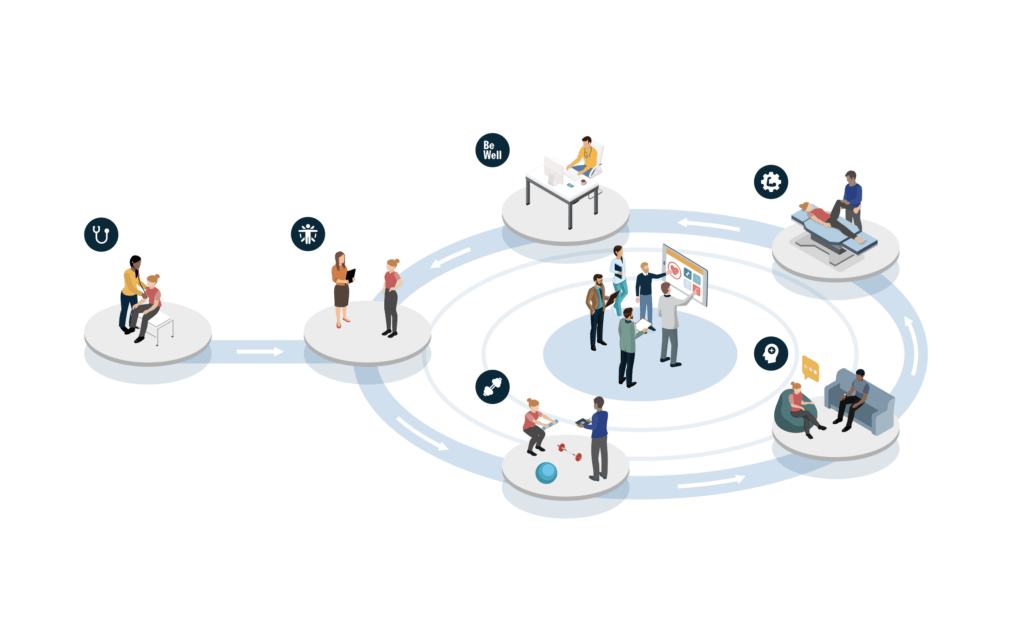
Blog
The Roadmap for Chronic Condition Management Starts with Trust
By Stephen Ezeji-Okoye, MD
Nearly half of all Americans – over 100 million and rising – have high blood pressure, or hypertension. This pervasive chronic disease is often referred to as the “silent killer” due to its lack of obvious symptoms. In fact, about one-third of people with high blood pressure aren’t even aware they have it and are not being treated to control it, putting them at high risk for heart disease and stroke, the first and fifth leading causes of death in this country.
While hiding in plain sight, this disease is not only deadly but economically crippling for our country, and particularly for self-insured employers and their people who shoulder an outsized share of the burden. Hypertension in the US accounts for over $130 billion in annual spending, including the cost of health services and medications. Compounding these costs are hypertension-associated comorbidities such as congestive heart failure and diabetes. On top of all of these direct costs is an estimated $11 billion annual loss in productivity due to associated absenteeism.
It doesn’t have to be this way. The inconvenient truth behind these dire statistics is this: With the right model of care in place, high blood pressure—like diabetes and other chronic conditions—is highly preventable and controllable. But not with the standard episodic sick care that most employees still engage in by default. Reining in hypertension requires a proactive population health management approach that targets root causes, treats the whole person, promotes self-efficacy, and measures success in outcomes, not visits. What does that look like in practice? Here are some of the key pillars of success we’ve been able to single out and study.
#1 – Foster trust throughout the member journey.
Hypertension, along with Type 2 diabetes, is a lifestyle-based disease that is aggravated by unhealthy diet, obesity, stress and other behavioral risk factors. For this reason, the most effective approaches to preventing and managing it are grounded in a biopsychosocial model of care that seeks to engage members in both understanding and addressing root causes.
At Crossover Health, we do this through a combination of preventive screenings, proactive outreach, and a multidisciplinary care team that includes health coaching, fitness, and mental health. The engine behind this model and its success is the member journey and our ability to promote what our CEO Scott Shreeve MD has described as member “flow”—both among care services (i.e., different disciplines) and across care channels (i.e., from in-person to virtual, with asynchronous messaging in between).
For hypertension as well as diabetes, our research has shown that the degree of flow and collaboration between a Crossover member’s primary care doctor and their health coach is a strong predictor of positive health outcomes. Specifically, when we looked at members in our primary care population between July 2019 and December 2022, we saw that members with high blood pressure who had at least one health coaching visit were 1.3 times as likely to have blood pressure controlled as members without a coaching visit. And for members with diabetes, the addition of a coaching visit made it 1.6 times more likely they would have their A1c levels under control.
These results can best be understood in the context of the real-world interactions of Crossover members with care team clinicians such as primary care physician Dr. Arshia Arjumand and health coach Shweta Verma. For Dr Arjumand, their close collaboration is a key to driving positive outcomes. “Our relationship is important. It builds trust when a member sees that we are communicating and collaborating over their care.” For a hypertensive member, the most typical care flow starts with the primary care doctor, usually at an annual physical. If high BP or cholesterol or weight gain is flagged, Arjumand says, she will refer them to a health coach such as Verma, who is also a registered dietician, or another in-team coach. In 90% of cases, she says, the appointment will be made on the spot. “We’re not sending them off, we’re handing them off.”
The member and their health coach will then co-develop an action plan with achievable 3-month goals—changes to diet and exercise routine, for example. Healthy weight management is foundational to prevention and control of both hypertension and diabetes. Recognizing how hard it can be to sustain a change to diet and exercise habits, health coaches step in to hold members’ hands in the day-to-day. “It’s not just, ‘here’s a plan, let’s talk in six months,’” says Verma. “It’s setting up a member with strategies and then checking back in after they’ve had time to experiment with them to see how it’s going.” If merited, she might also refer the member to an in-team fitness trainer to access classes and other resources —or to an in-team therapist if stress at work or home are compounding their condition. As the member moves through this journey, the goal is always to foster trust and build self-efficacy and confidence on the part of the member.

#2 – Meet members where they are in their busy lives.
For the average person who in a given day might have to juggle work, kids, elderly parents or other time-consuming demands, staying on course in the day-to-day management of a chronic disease can be challenging at best. That’s why it’s crucial to meet members where they are and give them the choice and autonomy they need in their busy lives to access care and support whenever and however it’s most convenient and effective for them.
At Crossover, this means offering members primary care, coaching, fitness, mental health counseling and other services in-person and virtually, with asynchronous messaging to bridge the experience across visits. And our data shows that enabling this kind of seamless flow across channels and modes of engagement makes a difference in outcomes. Our data shows that members with high blood pressure who access hybrid care—that is, both in-person and virtual—are 1.5 times as likely to have their blood pressure controlled as those who get care only in-person. This finding speaks to the importance of engagement and self-efficacy for managing conditions like hypertension. Making lifestyle changes is difficult and it’s easy to get derailed and slip back into unhealthy habits. The easier and more flexible it is for members to access coaching, therapy and other support when and how they need it, the more likely it is they will stay on track with their health goals.
#3 – Open the aperture to flag and address social determinants of health.
It is well-documented by now that as much as 80% of one’s health outcomes are determined by a range of non-medical factors, including race, income, and the environmental conditions in which people are born, live and work. With chronic conditions like hypertension and diabetes, multiple studies have shown how these social determinants not only put some individuals and communities at greater risk in the first place but can make it more difficult to then manage their condition. Someone, for example, who is worried about paying their rent or having their heat turned off may not be in a position to effectively control their blood pressure or glucose levels.
Our model seeks to address these health inequities by first recognizing that every member is an individual with different care needs and priorities, different strengths to tap and barriers to overcome. To see the big picture behind a member’s health and wellbeing, we regularly screen for a number of social determinants of health—including food access, housing instability, and financial vulnerability—that could put someone at greater risk of uncontrolled hypertension or diabetes. With guidance from these insights, and through trusted relationships with care teams, we can then help each member secure resources and set personal health goals that fit their specific circumstances.
With hypertension and diabetes on the rise, consuming more lives and more health spend for employers and employees every year, we cannot afford to stick with status quo sick-care models that aren’t putting a dent in the stark numbers. We know there is a proven alternative, and forward-thinking employers are in a position to lead the way forward. By adopting proactive integrated care models that treat the root causes of these deadly diseases we can put employees, and the nation, on a more promising path to health and wellbeing.
Frequently Asked Questions
What are some common chronic health conditions?
Some of the most common chronic conditions include heart disease, diabetes, asthma, COPD, arthritis, and hypertension (high blood pressure). These tend to require ongoing management.
How can I prevent chronic illnesses?
Leading a healthy lifestyle is the best way to prevent many chronic diseases. This includes eating a balanced diet, exercising regularly, avoiding tobacco, limiting alcohol, getting enough sleep, and managing stress. Regular checkups also help catch issues early.
What is a health coach and how can they help me?
A health coach is a trained professional who provides guidance, support, and accountability to help people make lifestyle changes to better manage chronic conditions. They create customized plans to address diet, exercise, sleep, stress, and more.
What workplace wellness initiatives help chronic disease?
Some examples include hosting onsite screenings, offering health coaching, holding fitness challenges, providing healthy food options, giving incentives for health behaviors, and more. These drive employee engagement with their health.
How does Crossover Health’s integrated care model benefit members with hypertension?
Data shows members who access both in-person and virtual care are 1.5 times as likely to get their blood pressure under control compared to in-person only, demonstrating the value of Crossover’s hybrid model.
What is the “silent killer” chronic condition that affects over 100 million Americans?
High blood pressure, or hypertension, is often referred to as the “silent killer” because it frequently has no obvious symptoms yet can lead to serious health issues if left untreated.
